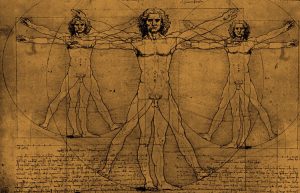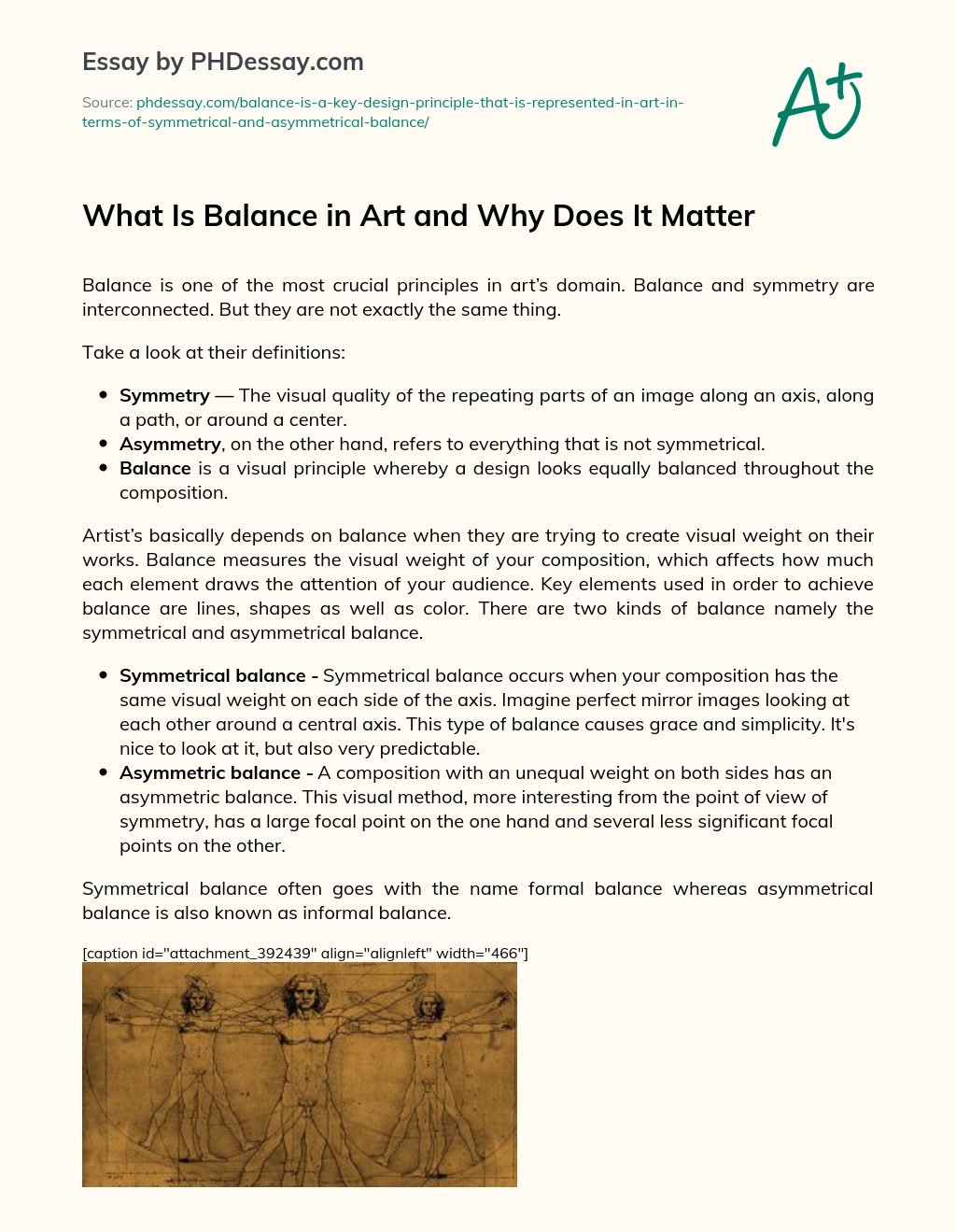What Is Balance in Art Terms? Rhythm in Art
Residual is 1 of the most crucial principles in fine art'south domain. Balance and symmetry are interconnected. Just they are not exactly the same matter.
Take a wait at their definitions:
- Symmetry — The visual quality of the repeating parts of an image forth an centrality, along a path, or around a center.
- Asymmetry, on the other hand, refers to everything that is not symmetrical.
- Residuum is a visual principle whereby a design looks equally balanced throughout the composition.
Gild custom essay What Is Balance in Art and Why Does It Matter with free plagiarism report
GET ORIGINAL Newspaper
Artist's basically depends on residue when they are trying to create visual weight on their works. Balance measures the visual weight of your composition, which affects how much each element draws the attention of your audience. Cardinal elements used in order to accomplish balance are lines, shapes likewise as color. There are two kinds of residue namely the symmetrical and asymmetrical balance.
- Symmetrical balance - Symmetrical remainder occurs when your limerick has the same visual weight on each side of the axis. Imagine perfect mirror images looking at each other around a cardinal axis. This type of residuum causes grace and simplicity. It's nice to await at information technology, just too very predictable.
- Asymmetric balance - A limerick with an unequal weight on both sides has an asymmetric balance. This visual method, more interesting from the signal of view of symmetry, has a large focal point on the i hand and several less significant focal points on the other.
Symmetrical balance often goes with the proper noun formal balance whereas asymmetrical balance is likewise known as breezy balance.
 Vitruvian Man by Leonardo Da Vinci
Vitruvian Man by Leonardo Da Vinci
Any work of art must exist balanced. Moreover, fifty-fifty the most expressive and dynamic composition is withal subject to the police force of equilibrium, because only in this way will it be completed. Merely what does this hateful?
When an artist depicts whatever objects, he distributes them on the plane of a canvass or canvas. Some of them are larger, some are smaller. Some are located on the left, some on the right ... This very distribution of objects in the sheet tin can create a feeling of motility, displacement, balance, etc.
In lodge to know which kind of rest is used by an artist one needs an imaginary line at the center of the artwork. Formal remainder is defined as something which depicts similar things from both sides of your imaginary line. In informal balance on the other hand both sides of imaginary lines incorporate different things and thus the other side seems to be a little heavier as compared to the other side. Informal balance is more psychological in nature in that it is usually felt rather than noticed.
Most of Da Vinci'due south works contains symmetrical balance. Da Vinci's Proportion of the Human being Effigy is highly symmetrical in nature. This particular work depicts how a man body could create different shapes such as circle, square, and triangle. In this particular work Da Vinci created remainder past creating appropriate proportion which gave birth to balance. The appearance of symmetrical balance in the Proportion of the Human Figure could be attributed to the fact that there had been an estimate symmetry in this particular work.
Equally compared to Leonardo Da Vinci, Deborah Butterfield uses more than asymmetrical balnce on her works rather than symmetrical. An case of asymmetrical balance on her work could exist plant on her Verde. By drawing an imaginary line at the middle we could basically run into that the one side is heavier than the other and they depict dissimilar things equally compared to Da Vinci'due south Proportion of the Human Effigy. In this item work Butterfield used steel to achieve her desired end.
The head of the horse seems to be weightless since it seems like simply a stick protruding as compared to its body which seems to be total of steel and thus appears heavier. This technique allowed her a great example of depicting asymmetrical balance in art.
When confronting symmetry with asymmetry, information technology must be remembered that the visual mass of a symmetric figure volition be greater than the mass of an disproportionate figure of a similar size and shape; symmetry creates residual in itself and is generally considered beautiful and harmonious. But there is a flip side to the coin - information technology is oft devoid of dynamics and may seem static and boring; asymmetry, equally the antipode of static symmetry, usually brings dynamics to the composition.
Composition is an integral part of a work of art. Compositional rules, techniques and means are based on the rich artistic experience of artists of many generations, but the compositional technique does not stand yet, it is constantly evolving, enriched by the creative practice of new masters.
References
- "Principles of Blueprint,"; The Artspace Team, 1997) Reference: Principles of Design [Electronic Version] from http://sjc. ceu. edu/departments/fine art/chp03. pdf.
- The Artspace Team. (1997). Balance [Electronic Version] from http://world wide web. peonqueen. com/ArtSpace/temp_exhib/art2/bal. html.

Related Questions
on What Is Balance in Art and Why Does It Matter
What does rest hateful in Art Design?
One of the key principles of design, balance, refers to the organization of visual elements and so that their visual weight is in harmony with 1 some other. Rather than actual mass, visual weight just ways an object'south ability to attract the viewer's eye.
What is asymmetrical residual in art?
Asymmetrical residuum is when you accept dissimilar visual art elements on either side of the central line, just all the same the images appear to exist balanced. Unlike Symmetrical Residuum, Asymmetrical Residuum is a fleck difficult to achieve in your artwork.
What elements are used to achieve balance in art?
Fundamental elements used in order to achieve balance are lines, shapes as well as color. There are two kinds of balance namely the symmetrical and asymmetrical residual. Symmetrical residual - Symmetrical remainder occurs when your composition has the same visual weight on each side of the axis.
What is symmetrical residuum in design?
The Definition of Symmetrical Balance Symmetrical balance occurs when you have ii identical sides of a blueprint with a central point of axis -- so if you cut the design in one-half, the left and correct are mirror images of each other. To exist considered perfectly symmetrical, a design needs to have equally weighted visuals on either side.
Did you know that nosotros take over 70,000 essays on iii,000 topics in our database?
Cite this folio
Explore how the human body functions as i unit in harmony in gild to life
Source: https://phdessay.com/balance-is-a-key-design-principle-that-is-represented-in-art-in-terms-of-symmetrical-and-asymmetrical-balance/
0 Response to "What Is Balance in Art Terms? Rhythm in Art"
Enregistrer un commentaire